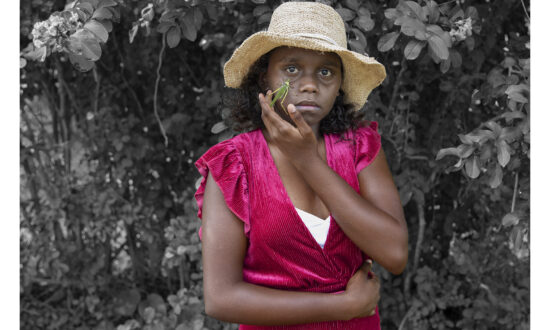Brisbane artist Richard Bell is one of the most effective of his generation. I say effective because he has advanced the cause of Indigenous Australians over decades with work that challenges and entertains but, above all, makes us think and face some inconvenient truths.
Bell has won many prizes over the years and has just added another to his quiver. He has been selected from among 28 finalists winning the 2023 King & Wood Mallesons First Nations Art Award. He pockets $25,000 for the biennial award which was held in Brisbane this year.
Bell’s work, a video piece, is on display now at the Griffith University Art Museum and he is in good company with an impressive list of finalists including Ryan Presley, Jennifer Herd, D. Harding, Ryan Presley and Qld local artist winner Keemon Williams whose photographic work is a celebration of black, queer joy. William’s work, Self Portrait (But I always wanted to be one of the Macho Men) is a “still-life dramatization of the interior self and its inheritances from those who’ve come before”.
The work features him dressed as a cowboy with echoes of The Village People. It is fun and thought- provoking.
Bell’s work, No Tin Shack, is a video telling the story of how his family was ordered by the Booringa Shire Council health inspector to pack their belongings of his childhood home (on the edge of the town of Mitchell) so that it could be demolished, leaving his family temporarily homeless.
It’s a serious work from an artist who is often playful, with an added biting wit. Who can forget his classic work which featured the statement Aboriginal Art – It’s A White Thing. Bell has worked with text in his paintings and his video work has often been satirical.
He once attended the Venice Biennale and filmed himself peeing in the canal there although it was just an illusion created with a bottle of water. Funny guy.
His travelling Aboriginal Tent Embassy is well known on the art and festival circuit as is Bell himself. He’s an engaging and entertaining speaker who doesn’t pull any punches.
His video No Tin Shack is more on the poignant side and award patron Djon Mundine praised the piece.
“In regard to Richard’s work No Tin Shack, when a child is abused, materially deprived and socially made to feel unimportant and irrelevant, that trauma is what we now call generational trauma that is carried in the person’s soul and physical body through successive generations,” Mundine says.
“Therefore, Richard’s work is so important. “
Mundine says when Bell was growing up shanty towns and Third World poverty conditions existed for Indigenous Australians at the edge of every town and city in Australia. Bell’s video work No Tin Shack interrogates that and as we approach the referendum on the voice it has added relevance.
Bell says he still remembers the day a vehicle pulled up outside his childhood home on the outskirts of Mitchell.
He describes the health inspector as “a pallid white man dressed in a pressed white shirt” and adds that he “took and instant dislike” to him. As you would.
After judging the house unfit, he told the family to pack their things so that the home could be demolished.
“We were stunned to say the least,” Bell says. “We knew there weren’t any places to move to in Mitchell at that time. However, there were two condemned houses. Mr. Health Inspector apparently arranged for one of those houses to be uncondemned where we didn’t live happily ever after.”

Get InReview in your inbox – free each Saturday. Local arts and culture – covered.
Thanks for signing up to the InReview newsletter.
Bell says he is thrilled to win the 2023 King & Wood Mallesons First Nations Art Award.
“Winning an award or prize is a humbling experience, finding ourselves wondering how fortunate we have been to win,” Bell says. “We momentarily feel sad for those who didn’t win.”
But only momentarily. You can see Bell smiling his cheeky smile as he says that. He has won many awards. It was winning the prestigious 2003 Telstra National Aboriginal & Torres Strait Islander Award that brought him to the attention of the wider community. He won with his painting Scientia E Metaphysica (Bell’s theorem) which featured that classic statement “Aboriginal Art – It’s A White Thing.” In the two decades since he has been maintaining the rage, entertaining us and challenging us and pricking the social conscience of the nation.
And his work continues.
The King & Wood Mallesons First Nations Art Award 2023 exhibition is on until October 15 at Griffith University Art Museum, 226 Grey Street, South Brisbane
kwmfnaa.com/2023-award-finalists
Support local arts journalism
Your support will help us continue the important work of InReview in publishing free professional journalism that celebrates, interrogates and amplifies arts and culture in South Australia.
Donate Here




